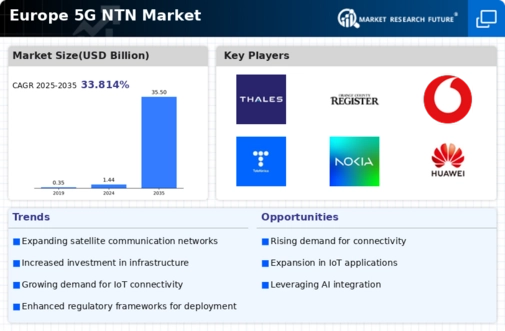The Europe 5G NTN (Non-Terrestrial Networks) Market is witnessing substantial competition as various players strive to establish their presence amidst a rapidly evolving technological landscape. This market segment has garnered significant attention, driven by the increasing demand for high-speed and reliable communication services across various sectors.
Competitive dynamics are influenced by the overarching need for enhanced connectivity solutions that integrate satellite and aerial technologies with terrestrial networks, allowing for seamless communication, especially in remote and underserved regions.
As the EU continues to prioritize digital transformation strategies, companies in the 5G NTN segment are focusing on innovation, partnerships, and the development of unique value propositions to capture market share. In this context, understanding the competitive landscape becomes vital for stakeholders looking to navigate the intricacies of the market effectively.
Thales has positioned itself as a strong contender in the Europe 5G NTN Market, leveraging its extensive expertise in satellite communications, data security, and advanced technologies. The company boasts a solid market presence driven by its commitment to innovation and rigorous research and development efforts.
Thales focuses on developing integrated solutions that enhance connectivity and meet the diverse needs of businesses and governments across Europe. Its strengths lie in its established reputation for reliability and security in communication technologies, which are vital in 5G NTN applications.
Moreover, Thales collaborates with various industry partners and stakeholders to accelerate the deployment of next-generation connectivity solutions, further solidifying its competitive edge in the European market.
On the other hand, Orange has made notable strides in the Europe 5G NTN Market by focusing on the convergence of satellite and terrestrial networks to provide comprehensive communication services. Known for its strong telecommunications infrastructure, Orange emphasizes the delivery of innovative solutions that enhance connectivity in both urban and rural regions.
The company offers a range of products and services tailored to meet the demands of various industries while capitalizing on its extensive customer base. Orange's strengths also stem from its strategic mergers and acquisitions, which have expanded its technological capabilities and access to critical resources in the satellite communications domain.
By investing in research and exploring partnerships, Orange continues to reinforce its position in the competitive landscape, aiming to drive advancements in 5G NTN capabilities across Europe and maintain its reputation as a leading provider of integrated connectivity solutions.






















Leave a Comment